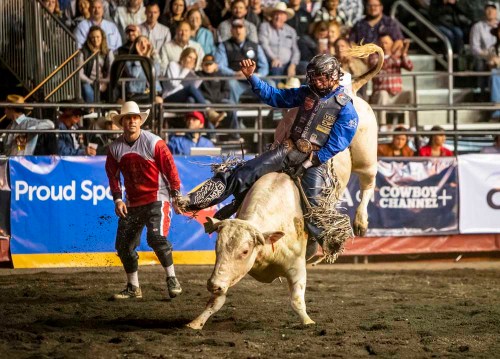Going pro in rodeo
Published 7:00 am Thursday, September 16, 2021

- Stetson Wright, of Milford, Utah, rides Rock Salt and Na on Monday, Sept. 13, 2021, for 84 points during the PRCA Xtreme Bulls Tour Finale at Happy Canyon Arena in Pendleton.
PENDLETON — It’s a difficult life to be a cowboy. It’s even more difficult to be a professional cowboy competing on the rodeo circuit.
For some, the draw of money and fame bring them into the world of professional rodeos, for others, it’s a family tradition. For all, however, it requires an immense amount of time and dedication.
Nearly everyone who makes it in the professional rodeo circuit was raised doing exactly what you see in the arena: throwing ropes around rebellious steers, spurring a horse around the ranch or trying to break a bronc.
“Most rodeo people have family that have done it at some point,” said Tom Sorey, who won the Pendleton Round-Up steer-roping title in 1996 and 1999. “I mean, it’s not the common sport that people just go to.”
But, it’s not unheard of for those who don’t live on ranches or farms to break into the sport and push to hit that sacred title of “professional.” For those competing in roping events, it’s definitely doable, Sorey said.
“Anybody can learn it,” he said. “It’s not that physically demanding, it’s just learning all the little things and having the time.”
For those interested, they’d need to spend some time on the land, learning from those who have competed previously.
In a perfect world, they’d rope and ride every night because horses need to be ridden nearly every day. But, there has been an evolution for training opportunities as technology has advanced.
“We’ve got some real neat tools that you can learn a whole lot faster these days than ever before,” Sorey said.
For roping, teams can pull dummies behind four-wheelers that the aspiring pro can chase down and rope. Or, there are newer mechanical dummies that let you work on your horse and yourself at slower speeds. But even with these advances, it doesn’t quite compare to live animals, which might cut in surprising directions or do the exact opposite of what is expected.
“You learn to read cattle as they move, and the horse does to some extent, but you help them make those decisions from above,” Sorey said. “And that’s just part of the challenge.”
There’s a lot of stuff that happens in roping that you won’t understand until you get into it, he said.
“I guess that’s what makes it fun,” he said. “It’s just you’re always learning something, always trying to find a better way; different ways and better ways and different ideas. You know, there’s not a real handbook.”
Beating the bulls
Bull riding doesn’t have much of a handbook either. Just give a little prayer before heading out into the packed arena, hold on as best you can for the necessary eight seconds and hope that you’re not one of the unlucky ones to walk away with a blown-out shoulder, shattered bones or permanent brain damage
For many professionals, it’s difficult to describe the feeling of riding a bull, much less how to successfully ride one. Riders can’t have a trace of fear as they climb onto a 1,500-pound bull, feeling its muscles flex and shiver in the chute, already trying to buck them off before the gate opens.
Fear has no place as they try to conquer the rocketing whipsaw under them, tendrils of bull spittle flying out in spirals and heavy hooves churning the dirt below. Stetson Wright, who placed second at the 2021 Xtreme Bulls finale in Pendleton on Tuesday, Sept. 14, and is the current world all-around leader, said some riders thought of it almost like a drug.
“Once you start,” he said, “you can’t stop.”
“We don’t get paid to think,” said Matt Palmer, who won the Tuesday finale. “We get paid to ride.”
Palmer said there’s not much strategy that goes into riding a bull. Everything happens so fast that there’s no time to think. It’s just split-second reactions.
“A lot of the time it’s just muscle memory,” Wright said.
For those trying to break into the sport, however, starting small is the way to go. Starting with riding barrels or mechanical bulls can help with timing and act as tune-ups for professionals, before moving onto smaller, easier bulls at jackpot rodeos, then working your way through the ranks.
For professionals such as Sage Kimzey, who won his fifth Xtreme Bulls Tour Championship on Sept. 14 and spends between two to six hours on the road every day, there isn’t an effective way or need to train for the event during the season — especially when he rides around 150 to 175 bulls a year.
“Whenever we were younger we’d practice a lot,” Kimzey said, “but once you kind of hit the pro rank it’s a little built-in.”
Kimzey, who still has a fitness coach and works on mobility and conditioning, doesn’t have much time for outside training aside from eating and staying healthy. This can be enough of a challenge for some, however, with the lack of healthy food on the road. Palmer basically relies on a diet of fast food and Red Bull while on the circuit.
For professionals, “If you’re not winning out on the road, then you go broke and have to go home and that’s where the practice comes back,” Kimzey said.
Riding bulls is dangerous. It’s a sport that leaves a trail of broken bones, torn muscles, gauged stomachs and crushed chest cavities. Despite the possible bodily harm, however, the key to riding is not physical. It’s not all about having the best arm strength or core workout. Instead, it is almost entirely a psychological sport.
“If you’re thinking about (it) before you get on, you’re already messing your head up, and bull riding is 90% mental,” Palmer said. “It’s all in your head.”







